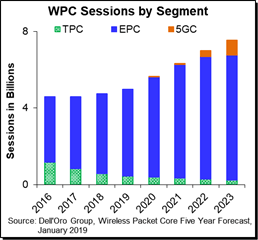2019 Broadband Access Market Outlook: Part 4 of 4
The introduction of more artificial intelligence (AI) and network automation services will allow operators to continue their push to become more than providers of broadband access services. These innovations will allow them to provide in-home network monitoring, troubleshooting, and maintenance issues. Comcast and AT&T have already begun to offer in-home WiFi management platforms, while Adtran, Calix, and other equipment vendors are also expanding their product portfolios to include intelligent, software-based control of CPE.
Just as broadband has become an essential service for most individuals, WiFi has also become a critical service. Like broadband, WiFi is also fraught with customer experience challenges. Broadband service providers are seeking to reduce these difficulties, while also reducing service calls. Introducing AI and network automation services presents a potential revenue opportunity though most operators would be satisfied with a reduction in WiFi-related service calls.
For a growing number of broadband providers, the picture is clear: To counter the economic and mindshare threat posed by OTT providers and consumer electronics players, broadband providers must become better at defining, controlling, and protecting the home-user experience because the home is where service providers most frequently interact with customers.
Operators are using a combination of software-based network managers along with intelligent, mesh-based WiFi extenders and routers to address a growing set of problems with home WiFi. One common problem is that traditional home routers, while powerful enough to generate a signal for most of a home, often have limited and clunky user interfaces. This makes it challenging for users to set specific network parameters or preferences. A second problem in larger or older homes is that brick and cinder block walls can quickly dampen a WiFi signal, creating dead spots. Historically, these dead spots have been addressed through the use of WiFi extenders, which simply repeat the signal generated by the central access point.
However, the problem with traditional WiFi extenders is two-fold:
- The extender can only do its job when it can detect the original WiFi signal.
- Each time the signal is repeated or extended, signal loss occurs to the tune of a 30% to 60% reduction in throughput.
Mesh networking capabilities from Plume, eero, Luma, Google, NetGear, D-Link, and similar companies do a far better job of maintaining a clean wireless signal though they still rely on signal repetition. By spacing multiple units throughout a home, these systems effectively create multi-hop communications for wireless devices. Essentially, when a wireless device receives or transmits data, it is either the first leg or anchor in a WiFi relay race. The data transfer then hops from one access point to another until it reaches the primary access point, which is connected to the DSL, cable, or fiber gateway. The multi-hop attributes of a mesh network reduce the distance the wireless signal must hop from one point to the next.
Just as important as improvement of the home WiFi signal is the increase in control users will be offered over their WiFi networks, passwords, and devices on networks with AI and network automation services. Operators will continue to expand their in-home network management apps as a means to retain broadband customers and also to expand into new services, including home automation and security. A centralized dashboard for controlling a customer’s total online experience is an important tool in the fight with Amazon, Google, Apple, Roku, and others to maintain control over the home experience.
To learn more about highlights on Broadband Access market in the next five years (2018-2023), please click here
Related blogs:
- 2019 Broadband Access Market Outlook: Part 1 of 4 – Marco Trends
- 2019 Broadband Access Market Outlook: Part 2 of 4 – Cable Operators Use Distributed Access as Their Platform for Edge Computing and Virtualization
- 2019 Broadband Access Market Outlook: Part 3 of 4 – Operators’ Implementation Early Use Cases for Artificial Intelligence and Network Automation


